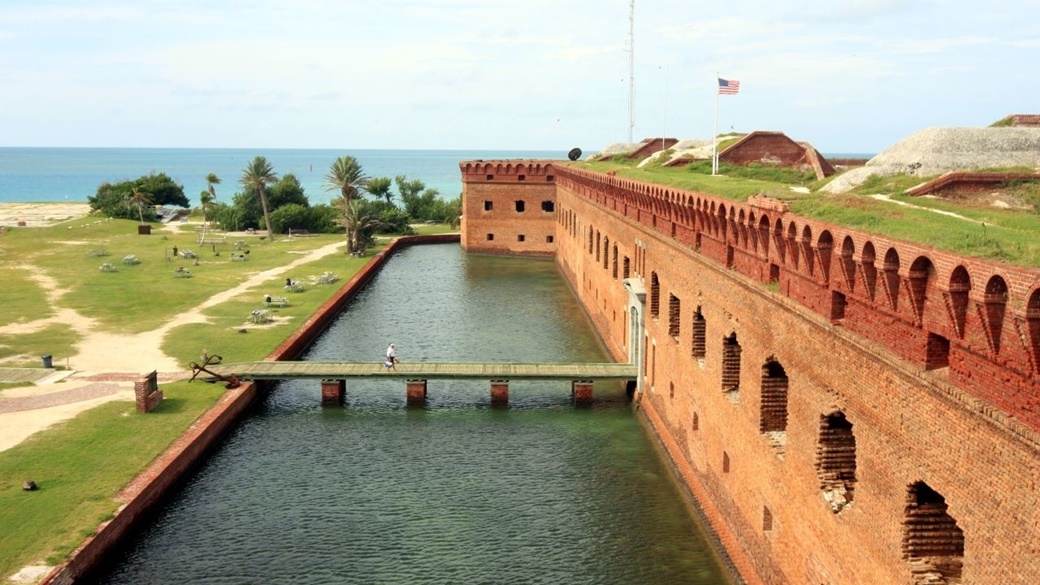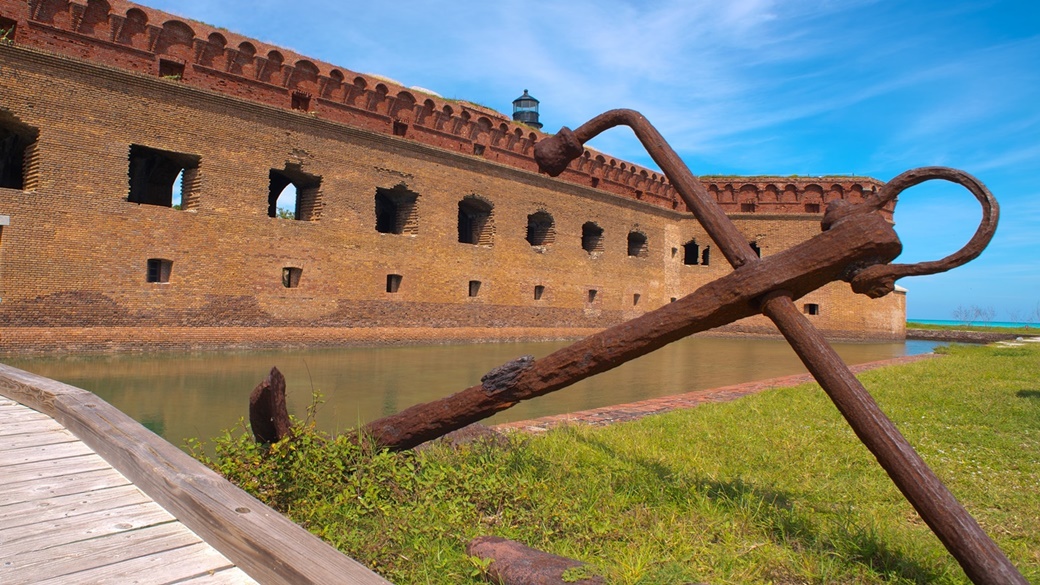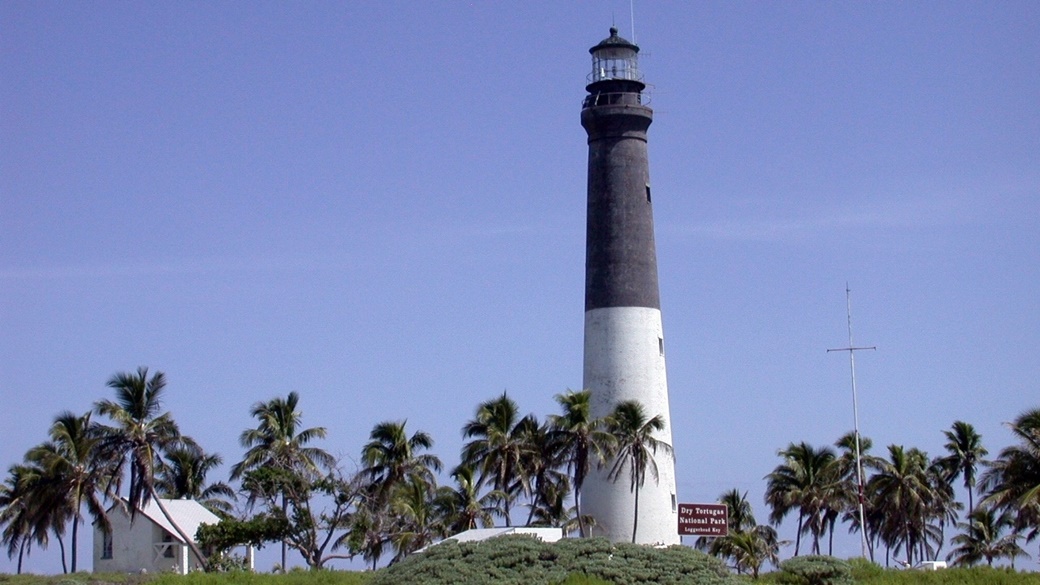Dry Tortugas is a marine national park in southern Florida, located 68 mi west of Key West. Over 99% of the park is Gulf of Mexico water, with a small portion of the mainland distributed among seven islands. The park is known for the nearly 200-year-old Fort Jefferson, which offers a truly once-in-a-lifetime experience.

Table of Contents
- Information on Dry Tortugas National Park
- Sights and Activities in Dry Tortugas National Park
- Best Time to Visit Dry Tortugas National Park
- Admission to Dry Tortugas National Park
- How to Get to Dry Tortugas National Park
- Lodging in Dry Tortugas National Park
- Tips and Recommendations Before Traveling to Dry Tortugas National Park
- Photos of Dry Tortugas National Park
Information on Dry Tortugas National Park
Dry Tortugas National Park is renowned for its abundant marine life, coral islands, shipwrecks, migratory birds, and a historic fort. It encompasses seven islands: the largest, Loggerhead Key, houses the Dry Tortugas Lighthouse, Garden Key is home to Fort Jefferson, and the remaining islands are Bush Key, Long Key, Hospital Key, Middle Key, and East Key. Why do they all contain ‘Key’ in their names? It’s derived from the Spanish word cayo, meaning island.
Spanning an area of 101 sqmi, it ranks among the smallest national parks and, with 83,817 annual visitors (as of 2021), one of the least visited. Its remoteness—accessible only by boat or seaplane—and the fact that Loggerhead Key, the highest point on the island, stands only 10 ft above sea level contribute to the lower visitor numbers.
The islands were first discovered by Europeans on June 21, 1513. Spanish navigator and explorer Juan Ponce de León named the islands after the 160 sea turtles he captured there. The turtles are called “tortugas” in Spanish, and the “dry” descriptor stems from the islands’ lack of fresh water. Dry Tortugas has been managed as a national monument since 1935 and was designated as a national park on October 26, 1992. This change was intended to provide greater protection for Fort Jefferson and its underwater resources, especially shipwrecks.
Less than 81 mi from the coast of Cuba, the Dry Tortugas archipelago often serves as a refuge for refugees traveling in rickety or inflatable boats.
There are 299 bird species throughout Dry Tortugas, but only eight species nest there permanently. For black-backed terns, common noddies, noble frigatebirds, and southern terns, it’s the only nesting site in the continental USA. The park also shelters five species of endangered sea turtles: the green, loggerhead, leatherback, Kemp’s ridley, and hawksbill. Sharks, American crocodiles, and vibrant, colorful coral reefs coexist in these waters.
Sights and Activities in Dry Tortugas National Park
The park’s main attraction is Fort Jefferson, an unfinished 19th-century fort designed to protect ships entering the Gulf of Mexico. Located on Garden Key, the second-largest island, the fort housed nearly 2,000 people at its zenith in the late 19th century. Interestingly, with 16 million red bricks, it’s the largest brick structure in the Western Hemisphere. Today, visitors can tour the fort with a guide or independently, which is highly recommended, as informative signs are placed throughout the park.
Another distinctive feature of the park is its lighthouses. An older one from 1826 is located on Garden Key, while a newer one from 1858 stands on Loggerhead Key.
Intrinsically linked to the lighthouses are shipwrecks; hundreds of vessels have sunk in Dry Tortugas waters since the 16th century. The first well-documented case was in 1622 when the Spanish ship Nuestra Senora del Rosario sank. The most infamous sinking involves the 262 ft sailing ship Avanti, which was wrecked near Loggerhead Reef on January 22, 1907. The high number of shipwrecks is attributed to the frequent storms and hurricanes in the region.
These submerged treasures attract divers from around the globe. Those intimidated by deep diving may prefer snorkeling. The water in Dry Tortugas is incredibly clear, teeming with a diverse range of marine life.
A unique way to appreciate the fort is from the water surface on a canoe or kayak trip. However, rentals are not available directly in the park; visitors must rent equipment in Key West or other parts of Florida.
Its remote location in the heart of the Gulf of Mexico makes the park an ideal destination for sport and recreational anglers. Several agencies specialize in this activity: they take you out to sea, rent you equipment, and you can fish to your heart’s content.
Best Time to Visit Dry Tortugas National Park
Dry Tortugas Park is open year-round, but the optimal time to visit is in April and May, with temperatures typically ranging between 70 °F–86 °F.
Key West experiences two distinct seasons: a cooler one from December to April and a warmer one for the remainder of the year. Tropical storms and hurricanes may disrupt these periods between June and November. Always check the current weather forecast before visiting.
Average Temperatures and Visitor Numbers in Dry Tortugas National Park
Average temperatures in Dry Tortugas National Park. Visitor numbers are based on a 2017-2021 average, the data source is the National Parks Service.
| Max Temp | Min Temp | Precipitation Days | Visitors | Popularity | |
|---|---|---|---|---|---|
| January | 75 °F | 66 °F | 4.5 | 5 408 | 🟨🟨 |
| February | 75 °F | 66 °F | 3.8 | 4 653 | 🟨🟨 |
| March | 79 °F | 70 °F | 4.2 | 7 070 | 🟧🟧🟧 |
| April | 81 °F | 73 °F | 5.0 | 6 745 | 🟨🟨 |
| May | 84 °F | 77 °F | 9.2 | 6 822 | 🟨🟨 |
| June | 88 °F | 79 °F | 15.2 | 7 321 | 🟧🟧🟧 |
| July | 88 °F | 81 °F | 15.9 | 6 811 | 🟨🟨 |
| August | 90 °F | 81 °F | 17.2 | 6 105 | 🟨🟨 |
| September | 88 °F | 79 °F | 17.0 | 4 432 | 🟨🟨 |
| October | 84 °F | 77 °F | 11.1 | 3 289 | 🟩 |
| November | 79 °F | 72 °F | 5.4 | 5 654 | 🟨🟨 |
| December | 77 °F | 68 °F | 4.4 | 5 243 | 🟨🟨 |
Admission to Dry Tortugas National Park
The entrance fee to Dry Tortugas National Park for a person over the age of 16 is $15.00 for one week. This fee is paid to the ferry and seaplane operators.
An America the Beautiful passport can be used for entry, which grants the holder access to all national parks (but not state parks) for 12 months from the first use. A new pass costs $80.
How to Get to Dry Tortugas National Park
Dry Tortugas National Park is among the most remote national parks in the USA. It can only be reached by seaplane, ferry, or private boat. In all cases, the trip tends to be relatively expensive.
A more affordable option is the Yankee Freedom II fast ferry, which departs from Key West Seaport at 8am each morning. However, it is advised to arrive at the terminal at least 45 minutes early. A round-trip ticket for an adult costs $200, while children aged 4 to 16 pay $145, and children younger than 4 sail for free. The ticket price includes breakfast, lunch, and snorkeling equipment for those interested. As these cruises tend to sell out quickly, it is recommended to book in advance:
The ferry arrives at Fort Jefferson. You can explore it, as well as Garden Key Island, on foot; the other six islands are accessible only by boat.
For transportation to Key West, a rental car is recommended (cheap car hire in Florida). Greyhound buses are available but can be uncomfortable. To provide an idea of the routes and commute times to Key West from several locations in Florida:
| From / To | Distance | Driving Time | Route |
|---|---|---|---|
| Miami | 160 mi | 3 hours 40 minutes | View Route |
| Fort Myers | 303 mi | 5 hours 20 minutes | View Route |
| Orlando | 394 mi | 6 hours 20 minutes | View Route |
| Tampa | 426 mi | 6 hours 50 minutes | View Route |
Parking for your car is available at the City Parking Garage on Grinnell Street, located right across from the ferry. The cost for a day of parking is $40. Although this might seem steep, there is no free parking in Key West.
A unique experience is a seaplane ride to Dry Tortugas coupled with a tour of the park. The four-hour trip costs $397 per person, including airfare. The longer eight-hour trip costs $697. These durations already include a round trip flight of 80 minutes.
Lodging in Dry Tortugas National Park
🏨 Hotels
The beauty of staying at a Florida fort is interspersed with splendid sunset views, but most visitors spend only part of the day in the park. Therefore, it’s advisable to look for accommodations in the nearby town of Key West. Dozens of hotels, motels, and resorts operate in this southernmost city in the continental USA.
⛺ Campsites
There’s one campground in Dry Tortugas National Park, located just south of Fort Jefferson. It offers 8 tent sites on a first-come, first-served basis. The fee per person per night is $15.00.
Tips and Recommendations Before Traveling to Dry Tortugas National Park
ℹ️ Visitor Center
The Dry Tortugas Park Visitor Center is located inside Fort Jefferson. A visit is highly recommended, as it’s open from dawn to dusk and features a 3D TV demonstration of underwater life, artifacts chronicling the fort’s history, and an exhibit dedicated to sea turtles.
👍 Good to Know
There are no restaurants, shops, or food stands in the national park, so all food and water should be purchased in Key West. It’s essential to stay hydrated. Don’t forget to bring a supply of sunscreen as well. With minimal shade on the islands, sunburn is a common issue.
If you find yourself near Key West during your visit to the USA, a tour of the park is a must-do. While a visit to Dry Tortugas is potentially one of the most expensive national park experiences outside of Alaska, it’s an experience of a lifetime. This place is truly unique.
Before visiting the park, download the information brochures to your phone and study them in the car during your journey. Some may be a bit lengthy, but they still provide interesting information that will enrich your trip.
Photos of Dry Tortugas National Park





US National Parks
- National Parks of the USA – Map, List and Annual Pass
- America the Beautiful Pass 2025 – How It Works, Cost & Parks
- Timed-Entry Reservation for US National Parks (2025 GUIDE)
Travel Guides to USA National Parks

 Follow wikiUSA on YouTube
Follow wikiUSA on YouTube




Contribute with Your Question or Personal Experience